Review: An exercise in Na’vi gazing, ‘Avatar: The Way of Water’ will cure your moviegoing blues
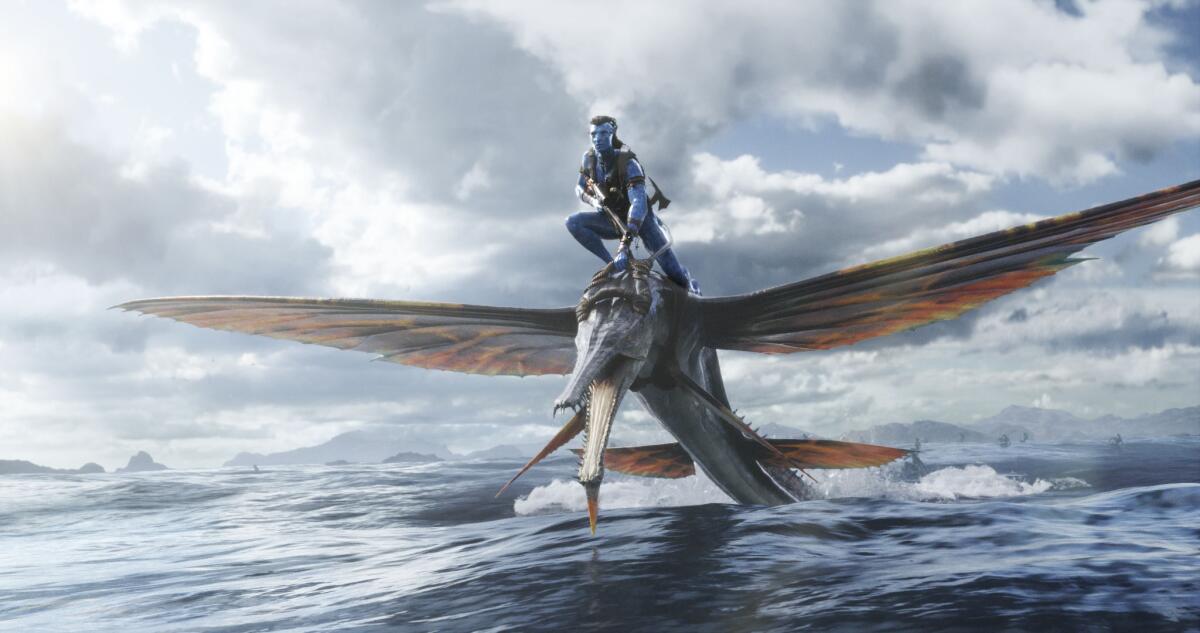
In “Avatar: The Way of Water,” the director James Cameron pulls you down so deep, and sets you so gently adrift, that at times you don’t feel like you’re watching a movie so much as floating in one. From time to time he brings you to the bottom of an alien sea, shot with stunning hyper-clarity in high-frame-rate 3D and teeming with all manner of surreally strange fish — all oddly shaped fins, decorative tentacles and other vestiges of an otherworldly, faintly screw-loose evolutionary timeline.
You can imagine the fun (and the headaches) that Cameron and his visual-effects wizards must have had designing this brilliant ocean-floor nirvana. You can also see an astronomical budget (reportedly north of $350 million) and an extraordinarily sophisticated digital toolkit at work, plus a flair for camera movement that, likely shaped by the director’s hours of deep-sea diving, achieves an exhilarating sense of buoyancy.
Much as you might long for Cameron to keep us down there — to give us, in effect, the most expensive and elaborate underwater hangout movie ever made — he can’t or won’t sustain all this dreamy Jacques-Cousteau-on-mushrooms wonderment for three-plus hours. He’s James Cameron, after all, and he has a stirringly old-fashioned story to tell, crap dialogue to dispense and, in time, a hell of an action movie to unleash, complete with fiery shipwrecks, deadly arrows and a whale-sized, tortoise-skinned creature known as a Tulkun. All in all, it’s marvelous to have him back (Cameron, that is, though the Tulkun is also welcome). He remains one of the few Hollywood visionaries who actually merits that much-abused term, and as such, he has more on his mind than just pummeling the audience into submission.
For your safety
The Times is committed to reviewing theatrical film releases during the COVID-19 pandemic. Because moviegoing carries risks during this time, we remind readers to follow health and safety guidelines as outlined by the CDC and local health officials.
Cameron wants to submerge you in another time and place, to seduce you into a state of pure, unforced astonishment. And he does, after some visual adjustment; the use of high frame rate (a sped-up 48 frames per second) tends to work better underwater than on dry land, where the overly frictionless, motion-smoothed look might put you briefly in mind of a Na’vi soap opera (“The Blue and the Beautiful,” surely). But then he can captivate you with something as lyrically simple — but actually, as painstakingly computer-generated — as a shot of his characters sitting beside the water at night, their faces and bodies reflecting the digital phosphorescence below. Any hack can make stuff blow up real good; Cameron makes stuff glow up real good.
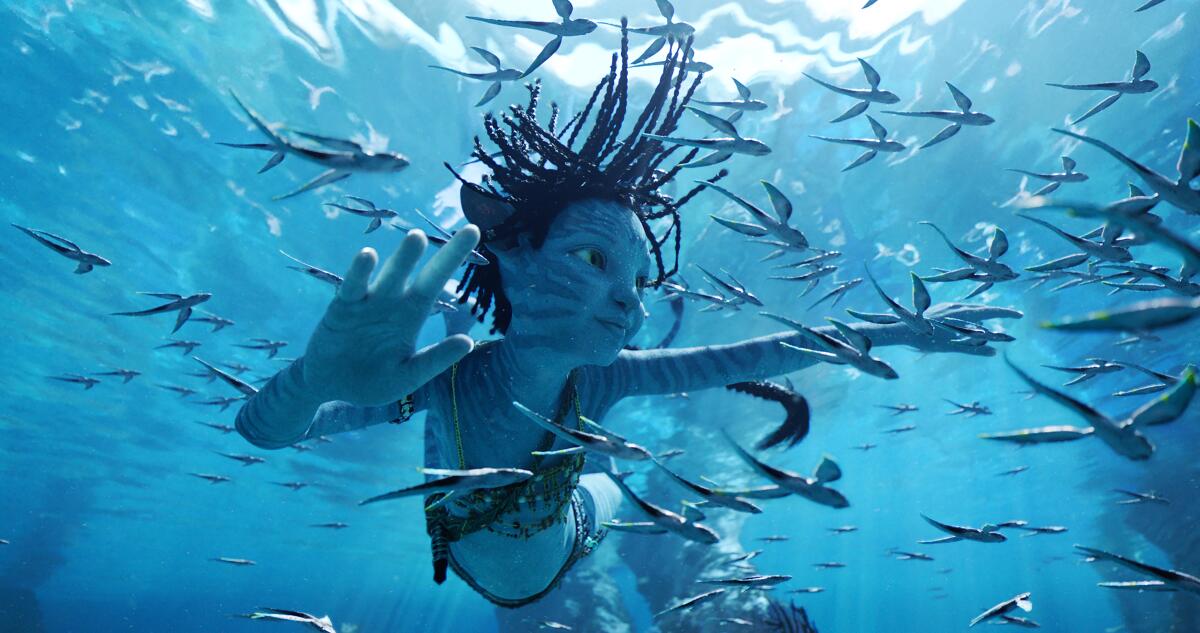
In this long-running, long-gestating sequel to his 2009 juggernaut, “Avatar,” Cameron returns you to that distant moon called Pandora, though most of the action unfolds far from the first movie’s majestic floating mountains and verdant rainforests. We encountered that dazzling, soon-to-be-despoiled Eden through the eyes of Jake Sully (Sam Worthington), a square-jawed, soft-hearted ex-Marine sent by his ruthless corporate overlords to infiltrate the Na’vi, a powerful race of blue-skinned, yellow-eyed, cat-tailed humanoids who lived in astonishing oneness with all living things. Transplanted into his own genetically tailored Na’vi body, or avatar, Jake didn’t take long to switch allegiances and turn against humanity, having fallen hopelessly in love with Pandora’s beauty and also with a Na’vi warrior princess, Neytiri (Zoe Saldaña).
“Avatar” was a thrilling moviegoing experience and a pioneering showpiece for performance-capture technology, which allowed Cameron and his actors to endow their Na’vi characters with astonishingly detailed and lifelike gazes, gestures and physiognomies. The movie was also built on a consciously thin story, with thudding echoes of anti-imperialist westerns like “Dances With Wolves” and the fondly remembered eco-conscious animation “FernGully: The Last Rainforest.” But then, Cameron’s cutting-edge technophilia has always been married to, and complemented by, an unapologetic cornball classicism. And if it was easy to snicker at “Avatar’s” hippy-dippy sincerity, it was also easy to surrender to its multiplex transcendentalism, its world of synthetically crafted natural wonders. Here was the rare studio picture that seemed enlivened, rather than undermined, by its contradictions.
If anything, those contradictions hit you with even greater force in “Avatar: The Way of Water,” which fully and subtly immerses you in the Na’vi world from start to finish. The level of computer-generated artifice on display in every landscape and seascape is cumulatively staggering, in ways to which even the first movie, toggling insistently between Jake’s human and Na’vi experiences, didn’t aspire. Just as crucially, the stakes have risen, the emotions have deepened and the brand-extension imperatives that typically govern sequels are happily nowhere in evidence.
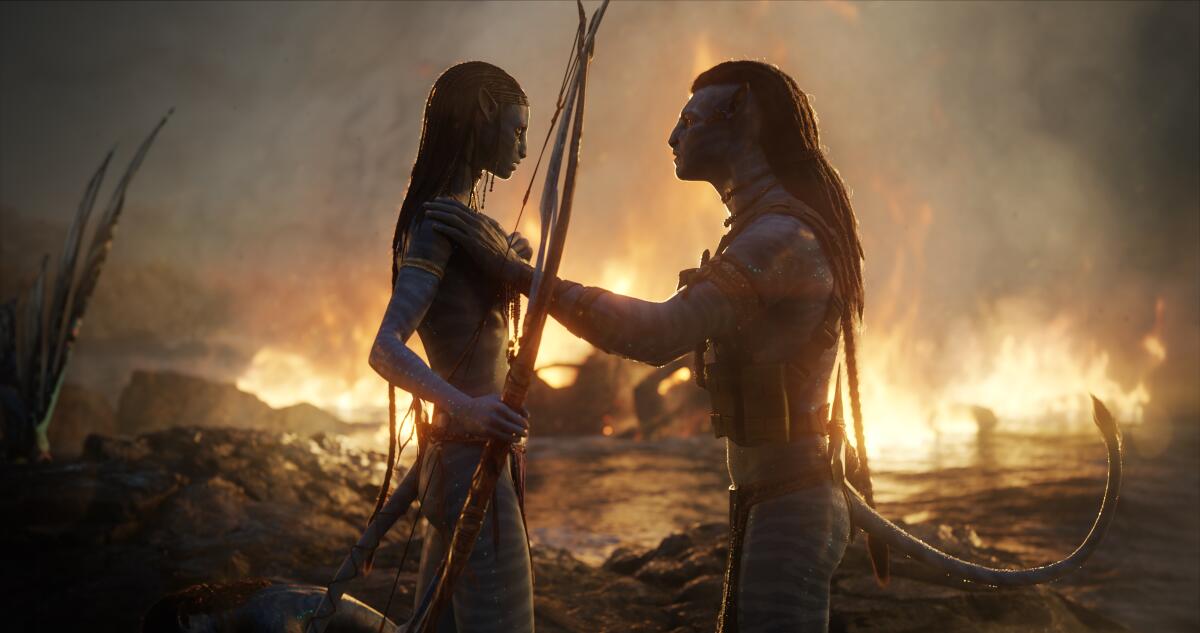
That might seem remarkable, considering that the “Avatar” series (at least three more movies are planned), like all properties of the former Fox Studios, now belongs to Disney, speaking of ruthless corporate overlords. But then, it’s no surprise that the director of “Aliens” and “Terminator 2: Judgment Day,” two of the most indelible sequels in action-cinema history, knows a thing or two about intelligent, expansive franchise building. And as “The Abyss” and “Titanic” bore out, Cameron also knows a thing or two about water, which is where this latest sequel finds its sweet spot: Welcome to Pandora’s beach.
But first, there’s a truckload of exposition to get through. As in the first movie, Jake obliges with the kind of grunting film-noir-gumshoe voiceover that reminds you, in ways more endearing than irritating, that snappy exposition will never be one of Cameron’s strong suits. (He co-wrote the script with Rick Jaffa and Amanda Silver.) Several years after shedding his own avatar and being reborn as a full-blown Na’vi, Jake has mastered his post-human way of life. He and Neytiri are parents to four Na’vi children: two teenage sons, Neteyam (Jamie Flatters) and Lo’ak (Britain Dalton); an 8-year-old daughter, Tuk (Trinity Bliss), and an adopted teenage daughter of mysterious provenance named Kiri. She’s played by Sigourney Weaver, a casting choice that naturally ties her to Dr. Grace Augustine, Weaver’s deceased scientist from the first movie, initiating a mystery that will presumably be unraveled further down the franchise road.
Weaver’s casting also raises some odd, potentially discourse-sowing questions about Kiri’s chaste (for now) bond with a young human male and fellow foundling named Spider (Jack Champion), who likes to run, bare of chest and foot, with the Sully clan. But if their friendship makes for an optimistic portrait of interspecies harmony, Cameron doesn’t linger on it for long. Instead, he unleashes a grave threat that drives Jake and Neytiri from their Omaticayan jungle home and sends them fleeing to the ocean, where they seek refuge with a civilization of Na’vi reef dwellers known as the Metkayina.
It’s a shrewd narrative gambit that not only refreshes the scenery (and how!) but also forces Jake, Neytiri and their family to adapt to an entirely new way of life, cueing a second-act training regimen that allows Cameron to show off every square inch of his aquatic paradise. (His key collaborators include his longtime cinematographer, Russell Carpenter, and production designers Dylan Cole and Ben Procter.)
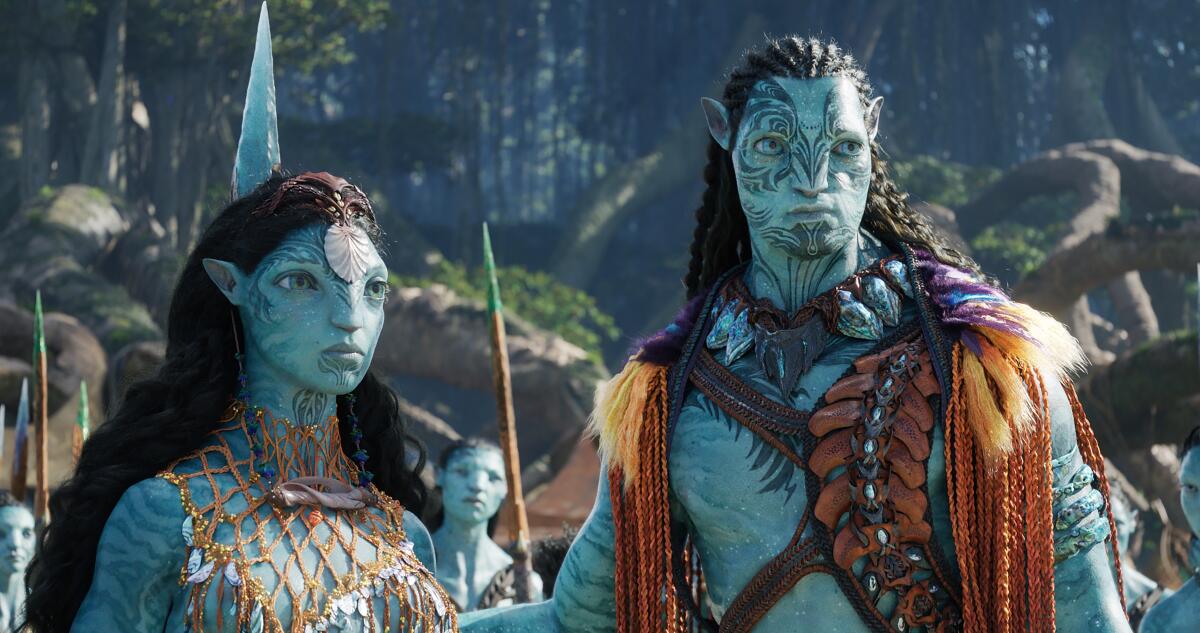
Led by the kind, welcoming Tonowari (Cliff Curtis) and his less hospitable wife, Ronal (a glaring Kate Winslet), the Metkayina are a highly evolved clan of water dwellers, as underscored by their aquamarine skin (in contrast to the Omaticayans’ cerulean tones), seashell-and-fishnet jewelry and intricate tattoos, reminiscent of Maori body art. They also boast unusually thick, long tails built for underwater propulsion. For Jake, Neytiri and especially their children, learning to navigate the watery wilderness just outside their new beach-bum paradise will prove a difficult challenge. It’ll also earn them some mockery from the locals, especially Tonowari and Ronal’s own teenage children, in a story that sometimes plays like a teen surfing movie by way of “Swiss Family Robinson.”
Even coming from a filmmaker used to setting intimate relational sagas against large-scale tragedy, the tenderness and occasional sentimentality with which Cameron invests this drama of family conflict and survival feels unusually personal. It can also feel a bit thinly stretched at three hours, but even that seems more an act of generosity than indulgence on Cameron’s part; his attachment to this family is real and in time, so is yours. Audiences expecting propulsive non-stop action, rather than the director’s customary slow build, may be surprised to find themselves watching a leisurely saga of overprotective parents and rebellious teens, biracial/adoptive identity issues and casual xenophobia. They’ll also be treated to some lovely whalespeak courtesy of those mammoth Tulkuns, who turn out to be engaging conversationalists as well as formidable fighters.
If you’re impatient, sit tight: The action is still to come, much of it dispensed by a snarling reincarnation of the first movie’s ex-military villain, Col. Miles Quaritch, here reborn — and played once more by the ferocious Stephen Lang — as a Na’vi avatar implanted with a surviving packet of the colonel’s memories. Bigger, badder and bluer than before, Quaritch 2.0 isn’t looking for unobtainium, the first movie’s stupidly, wonderfully named mineral MacGuffin. All he really wants is revenge against Jake and his family. (It’s personal for him, too.) His Na’vi transformation leaves only a handful of human characters, some of them old friends (Joel David Moore, Dileep Rao), though most of them are puny, inconsequential villains who rain down destruction on the Metkayina and their delicate ecosystem, only to reap destruction in return. Like its predecessor, “Avatar: The Way of Water” is both an environmental cautionary tale and a madly effective opportunity to root against our own kind; by the time the third act kicks in, you’ll be screaming for human blood.
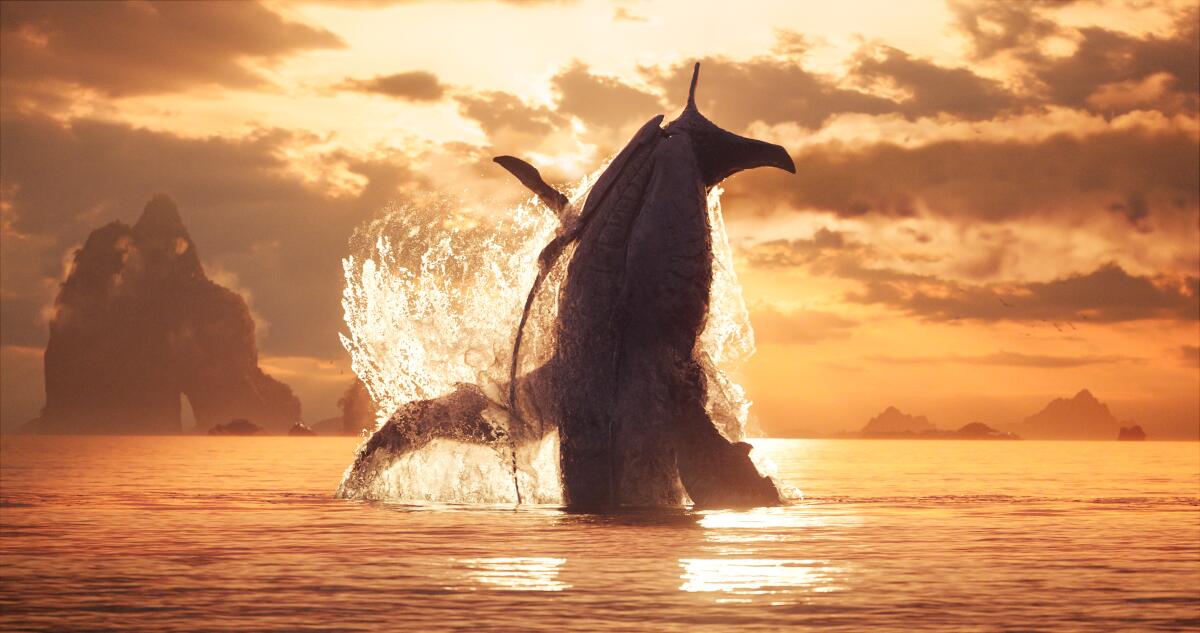
Cameron’s return trip to Pandora has been long in the making and nearly as long in the mocking. Over 13 years of ever-shifting industry buzz about possible sequels, sequels to sequels and countless changes of plan, more than a few have expressed exasperation with the director’s ever-outsized ambitions and even cast doubt on the first “Avatar’s” pop-cultural legacy. It’s hardly the first time Cameron has been dinged in advance for an Olympian folly, and if the pattern holds, this latest and most ambitious picture will stun most of his naysayers into silence. “Never underestimate James Cameron” has become something of a mantra of late when, in fact, the underestimation is crucial. It’s part of the director’s hook, his wind-up showmanship, his belief that moviegoing can be a religious and even redemptive experience. The more he suffers, the more he can thrill us, and the more fully the wonder of cinema can be reborn.
You don’t have to buy into that self-mythologizing to surrender, even if only intermittently, to the lovely, uneven, transporting sprawl of “Avatar: The Way of Water.” Certainly it’s hard not to feel moved and even heartened by the conviction of Cameron’s filmmaking, the unfeigned sincerity with which he directs a young Metkayina woman to solemnly intone, “The way of water has no beginning and no end.” That could be interpreted as a dig at the running time, but it also nicely articulates Cameron’s sense of visual continuity. As with the first “Avatar,” the immersive fluidity he achieves here feels like an organic outgrowth from his premise, a reminder that all life flows harmoniously together.
Where it will flow next is a mystery, and it’d be disingenuous of me to suggest I’m not eager to find out. Until then, Pandora, so long, and thanks for all the fish.
‘Avatar: The Way of Water’
In English and Na’vi dialogue with English subtitles
Rated: PG-13, for sequences of strong violence and intense action, partial nudity and some strong language
Running time: 3 hours, 10 minutes
Playing: Starts Dec. 16 in general release
More to Read
Only good movies
Get the Indie Focus newsletter, Mark Olsen's weekly guide to the world of cinema.
You may occasionally receive promotional content from the Los Angeles Times.










